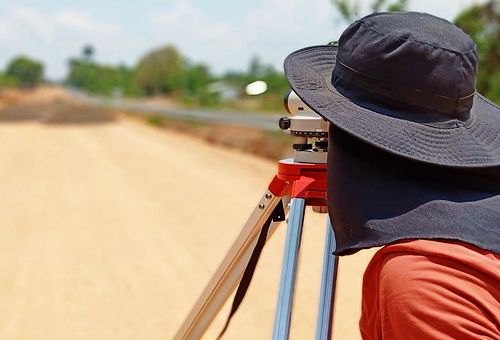Best land surveyor specialists in Norkem Park, Gauteng
Top land surveyor specialists near you
Browse the best land surveyor experts and compare ratings and reviews.
Hire the best land surveyor specialist
Search Uptasker for the best land surveyor specialists - compare ratings and read reviews
Don’t know your property boundaries? Call in a Land Surveyor to give you the answer.
The ever-reliable Wikipedia defines this profession as : “Surveying or land surveying is the technique, profession, art, and science of determining the terrestrial or three-dimensional positions of points and the distances and angles between them. A land surveying professional is called a land surveyor”. Land surveyors are an essential resource when it comes to resolving disputes or simple queries about the borders of your property, as these specialists are trained and skilled in marking and documenting the location of legal property lines. It could be that you simply want to locate a specific point on a map. Land survey involves location and measurement of either artificial (man-made) or natural features using the sciences of mathematics, geometry, trigonometry, physics, engineering, metrology (the scientific study of measurement), regression analysis, programming languages and the law. Through his various tools, a land surveyor is able to measure specifics such as elevation, angles and boundaries on a property. Land surveyors do a variety of tasks such as updating boundary lines and preparing sites for construction in order to define legal ownership of any parcels of land. They produce plats of surveys and describe property. A plat is a map, drawn to scale, showing how a piece of land is divided. Plats can also legally dedicate land for roads and other rights-of-way/easements.
A land surveyor can assist by :
- Providing a property owner with the specific boundary lines (or property lines) of the property in cases where additional building work is to be carried out and has to remain within such boundaries. Such a survey will also indicate the original boundaries of a property where existing extensions or buildings are already in place. This will protect both the property owner and his neighbours, in that expansion onto one another’s property, whether knowingly or unknowingly, can often lead to legal disputes. A boundary survey will accurately define the property lines and hopefully prevent disputes;
- Carrying out construction surveys, usually on larger pieces of land, which stake out temporary or permanent structures already on the property, including walls, buildings, roads and utilities. These surveys are essential where large-scale improvements and/or renovations are planned;
- Undertaking location surveys, which provide additional information on the location of interior improvements. These types of survey are usually required for zoning permits and loan applications;
- Conducting site planning surveys, which are required for development permit applications. These surveys are used when designing housing estates, subdivisions, commercial and industrial sites, streets and highways;
- Conducting subdivision surveys when subdividing a large tract of land into smaller erfs or plots. This type of survey is also used in the layout of streets and drainage systems. These are often coupled with foundation surveys which collect the positional data on a foundation that has been poured and cured. This ensures that the foundation is constructed in the exact location and at the precise elevation as authorised in the site plan or subdivision plan;
- Carrying out topographic surveys, which are used to locate both natural and artificial topographic features such as fences, utilities, buildings, streams, trees, elevations, contours and improvements. This sort of survey might be used by architects and engineers in the planning of site improvements and developments;
- Providing data, in the form of contour lines, following a topographic survey which measures specific elevation points on a piece of land;
- Producing a measured survey, which is a building survey used to produce plans of a building, usually carried out prior to beginning or on the completion of renovation work in a commercial sphere;
- Providing data to assist in the digging and construction of mine shafts and galleries through mining surveys, which also provide calculations on the rock volume. This form of surveying uses specialised techniques to take into account vertical shafts and narrow passages;
- Either establishing the elevation at a given point or establishing a point at a given elevation through levelling surveys.
Land surveyors use various items of equipment, including :
- total stations
- theodolites (precision optical instrument used for measuring angles between designated visible points in the horizontal and vertical planes)
- GNSS (satellite navigation) receivers
- 3D scanners
- inclinometers (gradient meters)
- retroreflectors (which reflect radiation – usually light – back to its source with minimum scattering)
- LiDAR sensors (Light Detection and Ranging is a remote sensing method used to examine the surface of the Earth)
optical and digital levels - GIS (A geographic information system is a computer-based tool providing a conceptualised framework which provides the ability to capture and analyse spatial and geographic data)
surveying software - hand-held tablets
- subsurface locators
- drones
Surveyors typically carry out duties such as :
- Measuring distances and angles between points on, above and below the surface;
- Using known reference points to determine the exact location of important features;
- Researching land and survey records and land titles;
- Looking for evidence of previous boundaries to ascertain where boundary lines are located;
- Recording and verifying the accuracy of data and preparing reports, plots and maps;
- Establishing official land and water boundaries for deeds, leases and any other legal documentation and being able to attest to these findings in legal proceedings.
How do I find the right land surveyor for my needs?
Check their online ratings and customer reviews
Finding the right land surveyor for your needs depends exactly on those needs. Whether it is establishing property or boundary lines on vacant land, confirming the boundaries of your own property (or that of your neighbour!), trying to create a contour map of a new building site or an extensive vacant piece of land, or wanting to subdivide a property, or for any reason similar to the above, there is a land surveyor who is a specialist in the field you need. Any reputable house and home, renovation, building, construction or architectural magazine or publication will advertise these specialists, and they can be found through newspaper advertisements, the Yellow Pages, or by asking building and construction companies and people generally who have used their services. If you prefer, use your keyboard and do an online search through a site such as Uptasker, which lists per geographical location, making it easier for you to find one in your vicinity. Uptasker provides one-click links to websites, if available, and also provides very valuable customer reviews and online ratings, which will give you an immediate overview of a supplier’s level of service and customer satisfaction.
Top land surveyor tips

This is a profession which has been around for thousands of years, starting when man began building the first large structures, such as the Great Pyramid of Giza in Egypt, built in c. 2700 BCE, which clearly demonstrates the Egyptians’ incredible surveying skills, even with their comparatively rudimentary methods.
Before you start building your new garage, permanent garden shed, extension or lapa, particularly if it is close to what you consider to be your property line or boundary, make sure that you are not overstepping the mark, so to speak. If you choose to build on a part of your property which you have always considered to be yours, and later find out in a dispute that it belongs to your neighbour, you will legally be forced to knock it down or enter into very costly arbitration. And yes, it does happen! Call in the specialists to be sure you are going to be able to build without infringing anyone else’s property rights. For more tips and information, see Uptasker’s land surveyor articles.
Read Land Surveyor articles





